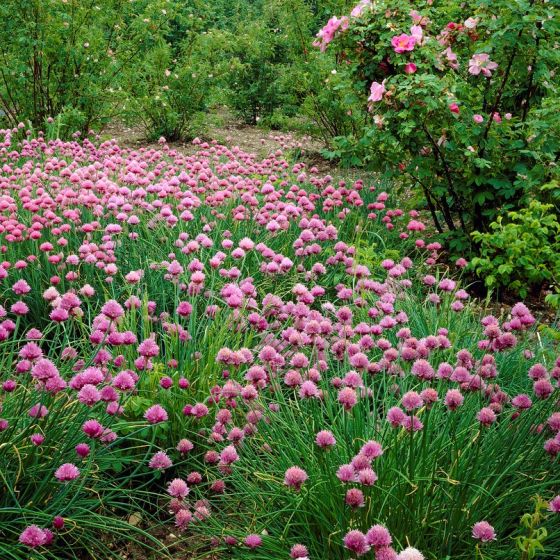homepage about chives sources pictures accessions desiderata languages contact links
about chives
Chives are those plants that are classified botanically and horticulturally as Allium schoenoprasum. There are other alliums that have "chive" as part of their full common or selling names, such as garlic chives (Chinese chives) which are Allium tuberosum, and blue chives (Siberian chives, Syrian chives) which are Allium nutans. They are not however chives. There are many more confusing descriptions for the ordinary gardener and such liberties also exist for garlic and onions themselves. For this reason I suggest you always use the common and botanical name when enquiring about cultivars ("varieties").
Chives are usually referred to in the plural because they are a clump of individual bulbs that have grown from single seeds (like spring onions) or dividing in cultivation (like shallots, but with more than one bulb!). It is this latter process that increases the size of the clumps of chives as the years go by. They are herbaceous perennials, which means the tops die down in late autumn sending all the plant's strength into the underground bulb to reappear again in the spring as the new season is warming up. They appear quite early but give them a chance to do some photosynthesizing before you start cutting to add flavour to your salad. Chives typically eventually grow to 30cm, or more, high and 30cm spread depending on the age of the clump of bulbs. However there are natural forms and garden cultivars that grow less tall and may have a more lax growth habit. There are forms that have thinner and very thin leaves. Flower colours can vary between mauve, purple, cerise, pink, coral, white, almost silver and even flowers replaced with small bulbils, sometimes called grass in other alliums. The size of the flowerhead can also vary in size particularly with the more dwarf white flowered forms which often have much smaller flowers. In the wild colours can vary considerably as well, but here as in the garden the predominant colour is purple.
Chives are hardy in the UK, as long as they are not in waterlogged soil. However they do like a moist soil so in dry areas they may not do well without additional watering. Like mint and parsley they are more suited to the vegetable garden than the less fertile and dryer condition preferred by the Mediterranean herbs like thyme, rosemary and sage. It is often advised to dig up your clump of chives every three years and divide the "plant" into smaller clumps and replant, to allow the group of individual bulbs more room to grow. Water well when replanting and "improve" the soil while you're at it. Add some fertiliser to the soil if replanting in the same place, but be sparing. Organic matter in some form is a better option as this often also contains small amounts of plant nutrients.
For culinary use flowering is a mixed blessing. The flowers themselves are edible and add different colours to salads and herb vinegars. On the other hand the stalk of the flower is hard and not of much use compared to the leaves and the plant will put it's energy into making seeds and not nice new soft leaves. If you want the leaves for culinary use remove the flowers and stalks before or just after flowering. This often means cutting lack the whole plant to ground level, so it is a good idea to give the plant a liquid feed in with a good watering to help the regrowth. New chive leaves will appear astonishingly quickly. Don't overdo the cutting to the ground too often, allow for some uninterrupted growth.
Chives can self-seed all over the place so it is good practice to cut the plants back anyway when flowers fade, unless of course you want to collect the seeds! But please be aware than most plants with cultivar names DO NOT come true from seed. They may be quite good or adequate plants but they ARE NOT the same plant as the named cultivar you got them from and do not call them that and confuse everyone else that comes into contact with them.
Most Garden Centres, Nurseries and even many Herb specialists only have the common purple flowered standard species of chives. If you are interested in a pink or white flowered form, or a thinner leaved form, you will need to search for them. The RHS website has a section called "Find a plant" (basically the old RHS Plant Finder online version mixed with the RHS Horticultural Database) which lists cultivars that are being sold by the Nurseries that have informed them of what they plan to have for sale. Some entries have no source listed! Some are listed as having a source but you will find some are no longer available, or at least not this year. Searches produce this result more often than you would like.
If the plant you buy from your Garden Centre, or mail order from a Nursery, has been grown from seed sown that year, it is not advisable to start cutting for kitchen use until the following year when the bulbs will be larger and able to recover more easily. If you do start cutting to early, like the kitchen chives from the Supermarket, don't expect them to last the year. They need time to build up strength from the leaves to produce a bulb big enough to get them through the winter and burst into growth again.
If you want to talk chives with me, please do, chat@chives.wales
Pests and Diseases
The RHS says that chives are generally trouble-free and that has been my experience up to 2019. The RHS are probably referring more to growing chives in the ground and I have always grown them in pots and containers. I did however loose a favourite well established plant in a 28 litre container over winter with no obvious signs of a problem. I did not examine the compost for the cause, which I should have.
Since collecting many more chive cultivars from multiple sources, and in threes where possible, I have acquired problems. Both are problems and not the "onion leaf rot" and "downy mildew" that the RHS said are possible. I have had "leek rust" and "Allium leaf-miner".
Leek rust is a fairly common disease on all sorts of members of the Allium genus, not just leeks. It is rarely fatal although very disfiguring and makes affected parts inedible. Chives being small become un-usable if they have a serious infection. Advice is generally to cut off the infected leaves, often meaning cut all the top growth to the ground, and removing every leaf, dead or alive. It may be a good idea to give a top dressing of organic matter (e.g. garden compost) to bury any spores. However if you do cut all top growth to a very young plant, whose bulbs have not fully developed, or even a plant of few individual bulbs (e. g. after slitting, too well) it's possible you will loose the plant: I have. If it is a very rare form then maybe cut individual leaves or leave it to see what happens.
Allium leaf-miner is a fairly new pest in the UK but is spreading past. I fear it came in with plants I bought as there is little evidence of it in this part of the world, but this is not a certainty. There is no remedy, chemical, organic, cultural, except covering plants in fine mesh April to May and October to November. The fly is 3mm so that's two months of very fine mesh affecting light levels. The fly lays it's eggs on the leaves after scrapping the surface to make life easier for it's offspring. They hatch and proceed to eat their way into the leaf and (in chives case at least) down towards the bulb) where they pupate until the next breeding season in the autumn or spring. Chives are made of very small bulbs and so the leaf-miner causes much more serious damage to the individual bulb than it does to a leek or onion. The chives bulb then dies from secondary infection and completely rots away. Ho hum. I'm afraid I do not have any advice, I am still keeping my fingers crossed.

chives will spread far and wide, eventually, if you let them self-seed
homepage about chives sources pictures accessions desiderata languages contact links


